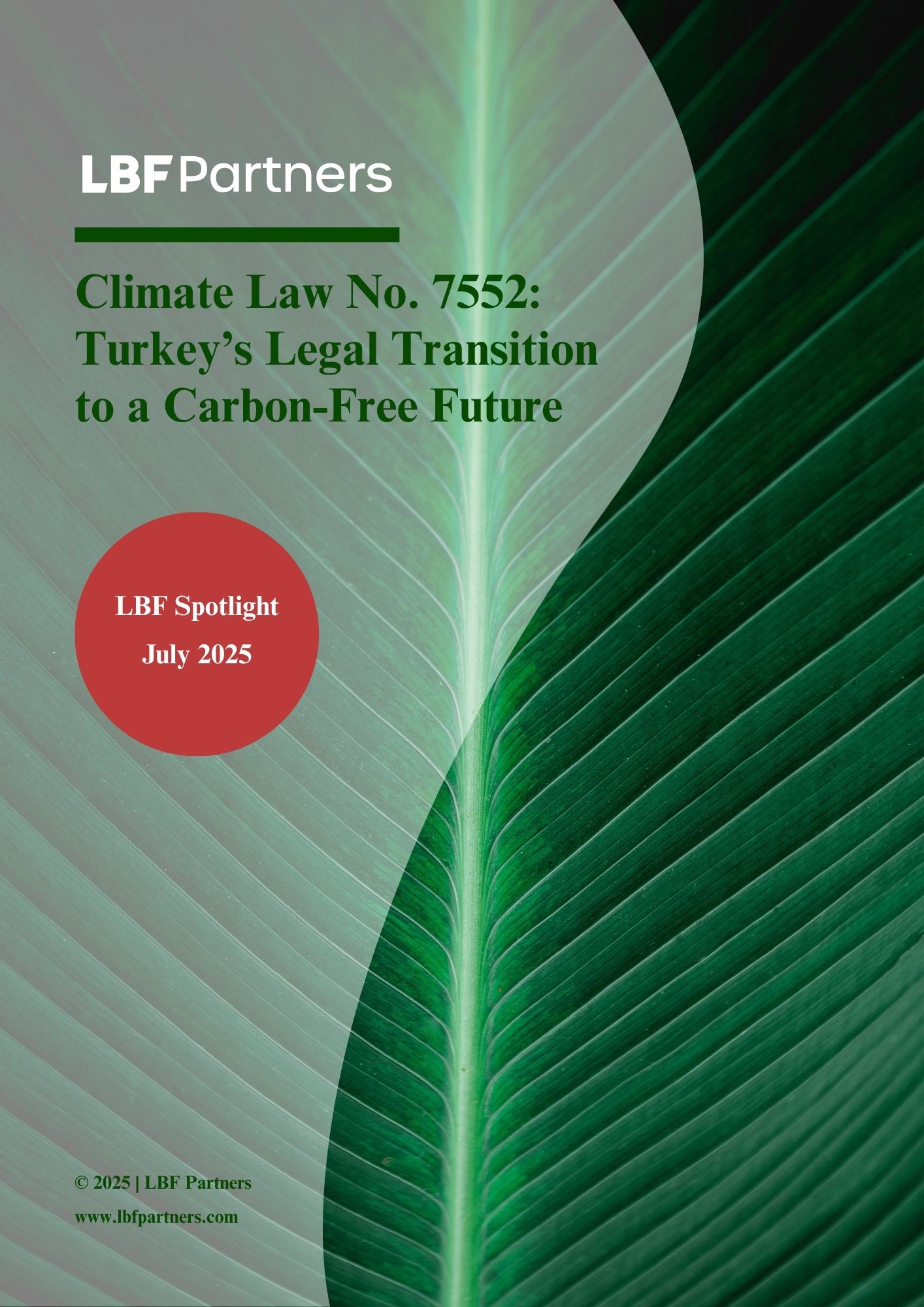Climate Law No. 7552: Turkey’s Legal Transition to a Carbon-Free Future
A) Introduction
Climate Law No. 7552 (“Climate Law” or “Law”), which entered into force upon publication in the Official Gazette on July 9, 2025 is Turkey’s first comprehensive framework law establishing a legal foundation for national climate change policies and strategies. The Law marks a significant milestone, particularly by incorporating into domestic legislation the obligations undertaken by Turkey under the Paris Agreement.
Drafted in alignment with the policy and strategy efforts initiated following the ratification of the Paris Agreement, the Law sets out the legal framework for the tools and mechanisms to be employed in pursuit of Turkey’s 2053 net-zero emissions target, as articulated in its Nationally Determined Contribution. The Law introduces key regulations on greenhouse gas emissions reduction, climate change adaptation, implementation and planning tools, and the establishment of an emissions trading system.
You can access the Climate Law here.
B) Nationally Determined Contribution, Net-Zero Emissions Target, and Climate Change Adaptation
The Nationally Determined Contribution (the “NDC”) which features prominently in the Climate Law, is grounded in the Paris Agreement. Under the Paris Agreement, each party is required to periodically prepare and submit an NDC to the Secretariat of the United Nations Framework Convention on Climate Change, setting out national targets and commitments for reducing greenhouse gas emissions and adapting to climate change. In its first updated NDC submitted in 2023, Turkey announced its target of achieving net-zero emissions by 2053.
Pursuant to the Climate Law, greenhouse gas emissions must be reduced in accordance with the NDC and the strategy and action plans issued by the Directorate of Climate Change under the Ministry of Environment, Urbanization and Climate Change (“Ministry”)
Under the Law, to achieve the net-zero emissions target, institutions and organizations are obliged to:
(i) implement the necessary measures set out in the Law, primarily in the sectors identified in the NDC, including improving energy, water, and raw material efficiency; preventing pollution at its source; increasing the use of renewable energy; and reducing carbon footprints; and
(ii) take measures to prevent the loss of carbon sinks in forests, agricultural lands, pastures, and wetlands, and to ensure the preservation and enhancement of sink areas and protected areas as part of emission offsetting efforts.
In addressing climate change, public institutions will prepare and implement plans that set out their medium- and long-term targets for both reducing greenhouse gas emissions and adapting to climate change. Progress toward these core objectives will be monitored by the Directorate of Climate Change. Relevant public institutions are required to carry out risk and impact analyses with a focus on climate change adaptation, to incorporate these analyses into their investment and planning processes, and to ensure their implementation.
The Law also mandates the preparation of local climate change action plans for each province to reduce greenhouse gas emissions and enhance climate change adaptation. These local action plans will be developed as comprehensive, province-wide strategies that incorporate the principles of a just transition and must be submitted to the Provincial Climate Change Coordination Board for approval.
All planning instruments and local action plans intended to serve these purposes must be finalized by December 31, 2027. The President is authorized to extend this deadline for up to one additional year.
C) Emissions Trading System
The Emissions Trading System (“ETS”), whose institutional basis is laid down by the Climate Law, is structured as a market-based mechanism to support Turkey’s efforts to reduce greenhouse gas emissions. The ETS will be established by the Directorate of Climate Change and operated by Enerji Piyasaları İşletme A.Ş. as the designated market operator.
Under the ETS, greenhouse gas emission allowances (allocations) will be granted for specific periods to entities engaged in activities that directly generate greenhouse gas emissions. These allocations will be tradable on the market. National plans determining the scope and volume of allocations will be prepared by the Directorate of Climate Change and published in the Official Gazette. The principles applicable to entities undertaking such emission-generating activities will be set out in a dedicated regulation.
At this stage, the key obligations under the ETS framework are to obtain a greenhouse gas emission permit from the Ministry within three years from the effective date of the Law, to align annual emissions with allocated allowances, to verify and report emission data, and to surrender the corresponding number of allowances. The three-year period for obtaining the emission permit may be extended by up to two additional years, if deemed necessary, by a decision of the Carbon Market Board.
The Law also allows entities subject to the ETS to offset part of their obligations using carbon credits derived from independently verified carbon reduction projects, in addition to their allocated allowances. Entities not covered by the ETS are also encouraged to participate in the voluntary carbon market.
The implementation of Turkey’s national ETS holds strategic significance not only for advancing national climate policy but also due to its implications for foreign trade. As part of the European Green Deal, the European Union (“EU”) has introduced the Carbon Border Adjustment Mechanism (“CBAM”), which will become fully operational on January 1, 2026, following the completion of its transitional phase. From that date onward, carbon emissions embedded in goods exported to the EU, such as iron and steel, fertilizers, cement, aluminium, and hydrogen will be subject to carbon pricing under CBAM. Another key consideration is that EU legislation permits the recognition and deduction of carbon pricing mechanisms applied in the country of origin when calculating the carbon cost payable under CBAM for exports to the EU. If Turkey’s ETS is aligned with the structure of the European Union’s system, carbon costs incurred domestically could potentially be credited at least in part, against CBAM liabilities. Accordingly, the ETS plays a critical role in maintaining the competitiveness of Turkish exporters in the EU market and in preventing double carbon pricing.
D) Sanctions and Pilot Phase
The Law expressly sets out administrative fines for breaches of obligations such as restrictions and prohibitions on greenhouse gas emission monitoring, regulations concerning ozone-depleting substances and fluorinated greenhouse gases, and rules related to the ETS. The maximum fine for each individual violation is capped at 50,000,000 Turkish lira.
To support the transition into full implementation, a pilot phase of the ETS will be conducted. The scope, duration, and procedural details of this phase will be determined by the Carbon Market Board. During the pilot phase, administrative fines stipulated in the Law will apply at a reduced rate, with an 80% reduction on their full amount.
E) Secondary Legislation
Secondary regulations are expected to be issued on several key areas addressed in the Law, including the ETS. These regulations are anticipated to be finalized within the transition period set forth in the Law.
F) Conclusion
Climate Law No. 7552 fills a critical gap by providing a legal framework for Turkey’s core principles and implementation tools in combating climate change.
While defining the institutional structures required to achieve national greenhouse gas emission targets, the Law also establishes the foundation for the ETS, which is expected to carry implications for foreign trade.
The forthcoming secondary legislation is expected to provide greater clarity regarding the implementation of the Law in the near future.
Climate Law No. 7552 (“Climate Law” or “Law”), which entered into force upon publication in the Official Gazette on July 9, 2025 is Turkey’s first comprehensive framework law establishing a legal foundation for national climate change policies and strategies. The Law marks a significant milestone, particularly by incorporating into domestic legislation the obligations undertaken by Turkey under the Paris Agreement.
Drafted in alignment with the policy and strategy efforts initiated following the ratification of the Paris Agreement, the Law sets out the legal framework for the tools and mechanisms to be employed in pursuit of Turkey’s 2053 net-zero emissions target, as articulated in its Nationally Determined Contribution. The Law introduces key regulations on greenhouse gas emissions reduction, climate change adaptation, implementation and planning tools, and the establishment of an emissions trading system.
You can access the Climate Law here.
B) Nationally Determined Contribution, Net-Zero Emissions Target, and Climate Change Adaptation
The Nationally Determined Contribution (the “NDC”) which features prominently in the Climate Law, is grounded in the Paris Agreement. Under the Paris Agreement, each party is required to periodically prepare and submit an NDC to the Secretariat of the United Nations Framework Convention on Climate Change, setting out national targets and commitments for reducing greenhouse gas emissions and adapting to climate change. In its first updated NDC submitted in 2023, Turkey announced its target of achieving net-zero emissions by 2053.
Pursuant to the Climate Law, greenhouse gas emissions must be reduced in accordance with the NDC and the strategy and action plans issued by the Directorate of Climate Change under the Ministry of Environment, Urbanization and Climate Change (“Ministry”)
Under the Law, to achieve the net-zero emissions target, institutions and organizations are obliged to:
(i) implement the necessary measures set out in the Law, primarily in the sectors identified in the NDC, including improving energy, water, and raw material efficiency; preventing pollution at its source; increasing the use of renewable energy; and reducing carbon footprints; and
(ii) take measures to prevent the loss of carbon sinks in forests, agricultural lands, pastures, and wetlands, and to ensure the preservation and enhancement of sink areas and protected areas as part of emission offsetting efforts.
In addressing climate change, public institutions will prepare and implement plans that set out their medium- and long-term targets for both reducing greenhouse gas emissions and adapting to climate change. Progress toward these core objectives will be monitored by the Directorate of Climate Change. Relevant public institutions are required to carry out risk and impact analyses with a focus on climate change adaptation, to incorporate these analyses into their investment and planning processes, and to ensure their implementation.
The Law also mandates the preparation of local climate change action plans for each province to reduce greenhouse gas emissions and enhance climate change adaptation. These local action plans will be developed as comprehensive, province-wide strategies that incorporate the principles of a just transition and must be submitted to the Provincial Climate Change Coordination Board for approval.
All planning instruments and local action plans intended to serve these purposes must be finalized by December 31, 2027. The President is authorized to extend this deadline for up to one additional year.
C) Emissions Trading System
The Emissions Trading System (“ETS”), whose institutional basis is laid down by the Climate Law, is structured as a market-based mechanism to support Turkey’s efforts to reduce greenhouse gas emissions. The ETS will be established by the Directorate of Climate Change and operated by Enerji Piyasaları İşletme A.Ş. as the designated market operator.
Under the ETS, greenhouse gas emission allowances (allocations) will be granted for specific periods to entities engaged in activities that directly generate greenhouse gas emissions. These allocations will be tradable on the market. National plans determining the scope and volume of allocations will be prepared by the Directorate of Climate Change and published in the Official Gazette. The principles applicable to entities undertaking such emission-generating activities will be set out in a dedicated regulation.
At this stage, the key obligations under the ETS framework are to obtain a greenhouse gas emission permit from the Ministry within three years from the effective date of the Law, to align annual emissions with allocated allowances, to verify and report emission data, and to surrender the corresponding number of allowances. The three-year period for obtaining the emission permit may be extended by up to two additional years, if deemed necessary, by a decision of the Carbon Market Board.
The Law also allows entities subject to the ETS to offset part of their obligations using carbon credits derived from independently verified carbon reduction projects, in addition to their allocated allowances. Entities not covered by the ETS are also encouraged to participate in the voluntary carbon market.
The implementation of Turkey’s national ETS holds strategic significance not only for advancing national climate policy but also due to its implications for foreign trade. As part of the European Green Deal, the European Union (“EU”) has introduced the Carbon Border Adjustment Mechanism (“CBAM”), which will become fully operational on January 1, 2026, following the completion of its transitional phase. From that date onward, carbon emissions embedded in goods exported to the EU, such as iron and steel, fertilizers, cement, aluminium, and hydrogen will be subject to carbon pricing under CBAM. Another key consideration is that EU legislation permits the recognition and deduction of carbon pricing mechanisms applied in the country of origin when calculating the carbon cost payable under CBAM for exports to the EU. If Turkey’s ETS is aligned with the structure of the European Union’s system, carbon costs incurred domestically could potentially be credited at least in part, against CBAM liabilities. Accordingly, the ETS plays a critical role in maintaining the competitiveness of Turkish exporters in the EU market and in preventing double carbon pricing.
D) Sanctions and Pilot Phase
The Law expressly sets out administrative fines for breaches of obligations such as restrictions and prohibitions on greenhouse gas emission monitoring, regulations concerning ozone-depleting substances and fluorinated greenhouse gases, and rules related to the ETS. The maximum fine for each individual violation is capped at 50,000,000 Turkish lira.
To support the transition into full implementation, a pilot phase of the ETS will be conducted. The scope, duration, and procedural details of this phase will be determined by the Carbon Market Board. During the pilot phase, administrative fines stipulated in the Law will apply at a reduced rate, with an 80% reduction on their full amount.
E) Secondary Legislation
Secondary regulations are expected to be issued on several key areas addressed in the Law, including the ETS. These regulations are anticipated to be finalized within the transition period set forth in the Law.
F) Conclusion
Climate Law No. 7552 fills a critical gap by providing a legal framework for Turkey’s core principles and implementation tools in combating climate change.
While defining the institutional structures required to achieve national greenhouse gas emission targets, the Law also establishes the foundation for the ETS, which is expected to carry implications for foreign trade.
The forthcoming secondary legislation is expected to provide greater clarity regarding the implementation of the Law in the near future.








 Download PDF
Download PDF

 e.copur@lbfpartners.com
e.copur@lbfpartners.com

